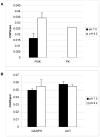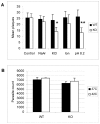Toxoplasma gondii lysine acetyltransferase GCN5-A functions in the cellular response to alkaline stress and expression of cyst genes
- PMID: 21179246
- PMCID: PMC3003489
- DOI: 10.1371/journal.ppat.1001232
Toxoplasma gondii lysine acetyltransferase GCN5-A functions in the cellular response to alkaline stress and expression of cyst genes
Abstract
Parasitic protozoa such as the apicomplexan Toxoplasma gondii progress through their life cycle in response to stimuli in the environment or host organism. Very little is known about how proliferating tachyzoites reprogram their expressed genome in response to stresses that prompt development into latent bradyzoite cysts. We have previously linked histone acetylation with the expression of stage-specific genes, but the factors involved remain to be determined. We sought to determine if GCN5, which operates as a transcriptional co-activator by virtue of its histone acetyltransferase (HAT) activity, contributed to stress-induced changes in gene expression in Toxoplasma. In contrast to other lower eukaryotes, Toxoplasma has duplicated its GCN5 lysine acetyltransferase (KAT). Disruption of the gene encoding for TgGCN5-A in type I RH strain did not produce a severe phenotype under normal culture conditions, but here we show that the TgGCN5-A null mutant is deficient in responding to alkaline pH, a common stress used to induce bradyzoite differentiation in vitro. We performed a genome-wide analysis of the Toxoplasma transcriptional response to alkaline pH stress, finding that parasites deleted for TgGCN5-A fail to up-regulate 74% of the stress response genes that are induced 2-fold or more in wild-type. Using chromatin immunoprecipitation, we verify an enrichment of TgGCN5-A at the upstream regions of genes activated by alkaline pH exposure. The TgGCN5-A knockout is also incapable of up-regulating key marker genes expressed during development of the latent cyst form, and is impaired in its ability to recover from alkaline stress. Complementation of the TgGCN5-A knockout restores the expression of these stress-induced genes and reverses the stress recovery defect. These results establish TgGCN5-A as a major contributor to the alkaline stress response in RH strain Toxoplasma.
Conflict of interest statement
The authors have declared that no competing interests exist.
Figures








References
-
- Wong SY, Remington JS. Biology of Toxoplasma gondii. AIDS. 1993;7:299–316. - PubMed
Publication types
MeSH terms
Substances
Grants and funding
LinkOut - more resources
Full Text Sources
Molecular Biology Databases

